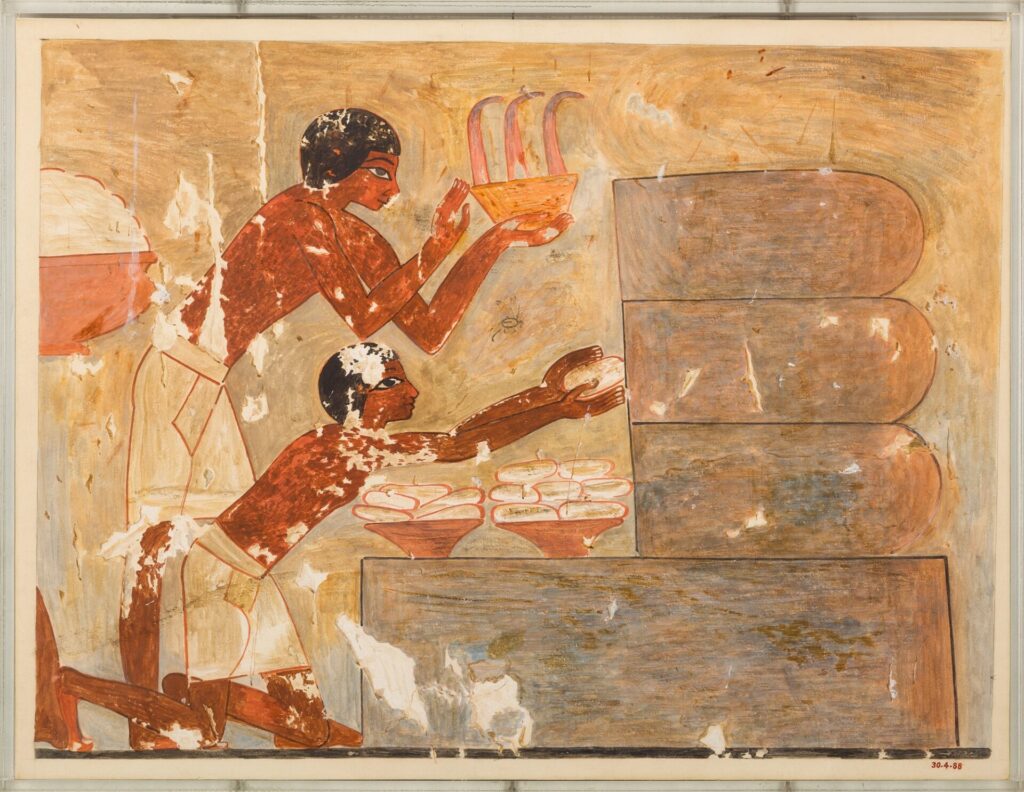Classics and comics.
Recently I stumbled upon a few unusual, if not downright quirky clashes of superheroes and antiquity. The more I thought about it the more I realised that this wasn’t really a far-fetched idea. After all – why should Hercules get all the attention?
Batman.
Batman’s earliest foray into antiquity (that I could find) occurred in 1944 in the story It happened in Rome.
Batman and Robin are sent back via the hypnotic abilities of Professor Nichols, and the two unearth mass corruption amongst the elite of Rome. Holy you could just have read Tacticus!
Going one step further and again using the coincidentally convenient skills of Professor Nichols the dynamic duo decide to visit the Olympic games after wondering how the athletes trained. This was the setting for Batman Peril in Greece which came out in 1946.

Needless to say mischief is afoot, in the form of the Persians who aim to have their men, dressed as Athenians, kill some Spartans. This woul cause a civil war which will destabilise Greece and allow the Persians to invade.
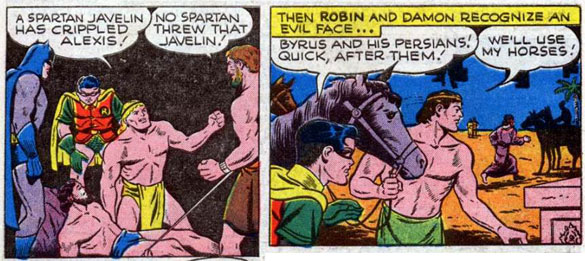
Not only do they foil the plan but Batman ends up competing in the games and joins Nero as the only other non-Greek to do so.

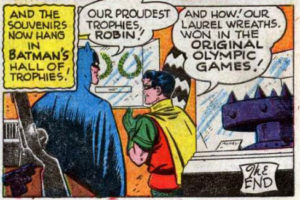
Both a fighter and a lover the man bat was back in 1951. This time encountering Cleopatra.
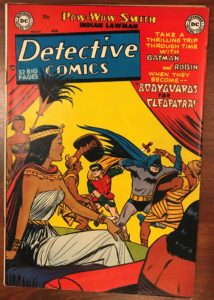
Bodyguards of Cleopatra involved the duo travelling back via a thoroughly explained and in depth analysis of time travel theory Professor Nichols. The story line is quite interesting. At an exhibit in Gotham museum the duo see a depiction of the bat-signal on a frieze. After Professor Nichols does his bit the caped crusaders help save Cleopatra and discover how the bat-signal got there.
Diana the Huntress.
Where Batman decided to save Greece from an ancient threat, Yellowjacket comics released a series of 10 comics in 1944 featuring Diana who is sent by Zeus so save her native Greece from the Nazis.
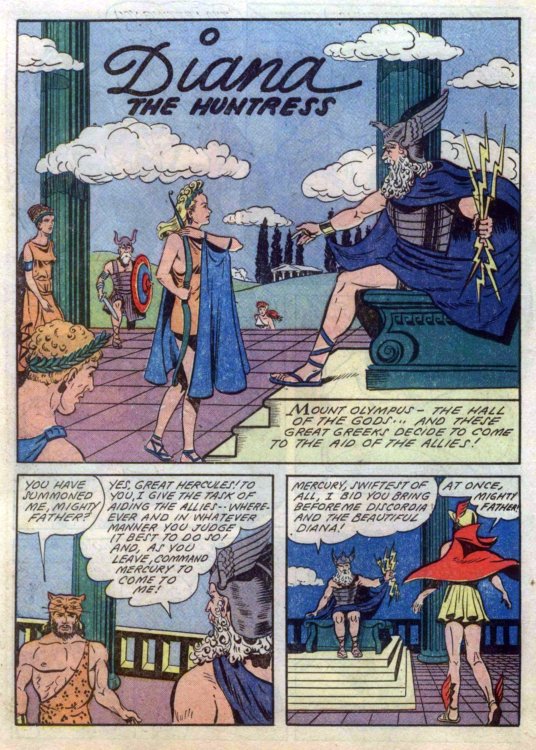
Deciding it’s best not to correct a God armed with thunderbolts over what your name is, Diana proceeds to earth and is assisted by a US soldier.

Rip Hunter Time Master.
In the 1950s Rip Hunter travelled back in time and met a few famous characters in the process.
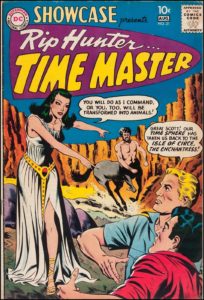
I’ve no idea how he got on with Circe though I’d be far more concerned with the centaur in the background. If you thought one dangerous female character was challenging Rip also got himself into something of a dilemma with two of them.
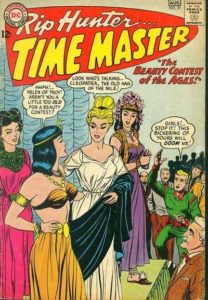
In Beauty Contest of the Ages (1964) Helen of Troy and Cleopatra face off in a beauty contest. I have no idea how this one goes so if you do I’d love to find out. Just tweet me. Rip wasn’t the only time traveller. In 1967 Mark Tyme ended up fighting gladiators on his debut adventure.
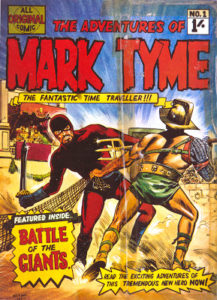 The importance of Gladiator fights is that no-one knows your secret identity
The importance of Gladiator fights is that no-one knows your secret identity
Mark seems to be up against a retiarius, albeit one who has put his manica and upper arm armour on the wrong arm. He’s also nicked what looks like a murmillo’s helmet. I’m sure this wasn’t bothering Mark though. Sadly Mark’s time device was broken in this encounter meaning he had to make smaller jumps back. We’ll never know whether he did as only two issues were published.
Superman.
The Man of Steel has a few run ins with figures from antiquity. The first is the ghost of Julius Caesar, sort of, in 1954. The story is based on the catchphrase of Perry White, Clarke Kent’s editor.

This particular tale carried over into the small screen and made into a TV episode. Both versions followed a similar theme, namely the fooling of Perry White at the Daily Planet. In the comic Superman helps the drama critic (Waldo Pippin) haunt Perry White until he gets two great scoops. The idea being to get Perry’s confidence back.
The TV episode involved Perry being fooled by a gang looking to discredit him ahead of a trial where he was to testify against them. This is how Caesar’s ghost looked in the tv show.

Lois Lane.
Lois became hugely popular spin off character and ended up with her own comic. In 1969 Lois was turned into a female centaur, or centauride. Both Philostratus the Elder and Ovid mention centaurides by the way. It wasn’t a modern invention.
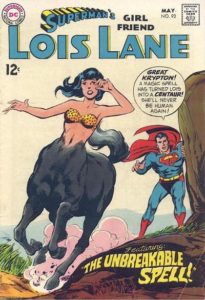
According to DC Wiki the story goes something like this:
“On assignment in the desert, Lois Lane is rescued by Comet the Super-Horse, and is later turned by Maaldor, Comet’s arch-enemy, into first a centaurette, then a super-powered horse”.

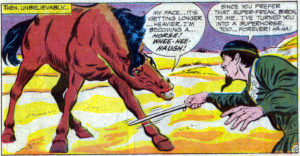
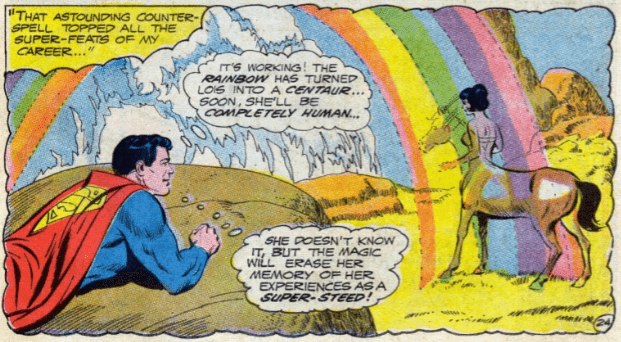
Elsewhere Lois ends up trying to stop Superman from three sirens. These are actually women with chameleonic powers who are impersonating Superman’s old flames.

If you don’t think poor Lois had suffered enough she even ended up as a slave girl. One thing I certainly learnt from researching this is that ‘Lois Lane’ and ‘Slave Girl’ in a search engine isn’t something you want to try at work. I’ll defer to the excellent DC wiki synopsis on this one
“Lois Lane is flung by a racketeer’s “time bomb” device back to ancient Rome, where she is sold as a slave into the house of one Crassus, who is secretly the heroic Petronius.”

Just to give some idea on the bids, a sercestes was around ¼ of a denarius. The highest bid is therefore 100 denarii. If anyone knows what that might buy you in late Republican Rome (I’m working on the idea that it’s that Crassus) I’d be grateful.
It wasn’t always modern-day folk travelling back in time, sometimes it was the reverse. In 1977 Julius Caesar invaded America and only one man could help. Step forward Captain America. Except this wasn’t a story, it was an advert. In the mid to late 70s comics started advertising with all the subtlety of a flying shield. In this instance Caesar is won over by the creamed filling of a twinkie. If only Vercingetorix had known his weakness.
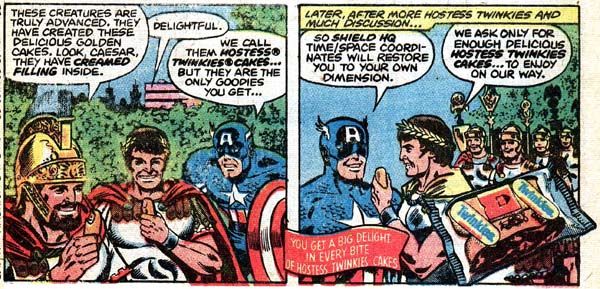
Epic stuff.
In addition to the standard superhero encounter or time travel comics often covered some of the myths. Here’s Marvel’s take on both the Odyssey and Iliad (1977).
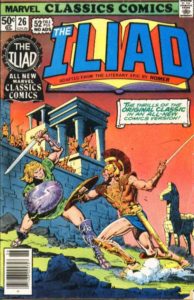

The comic book take on the Iliad wasn’t new, in 1950 Classics Illustrated had their own version.

Classics Illustrated had covered other famous stories from literature. In many ways the content of historical events and myths were great subject matter for comics. They were great stories with standout characters and plenty of action. In 1948 15 years before Elizabeth Taylor and Richard Burton took it to the big screes Antony and Cleopatra was published.

I suppose the idea of time travel gave the writers new ways to expand their characters and add twists. Having a character interact with already known places, people and events avoided the need to explain them. It’s also a nice variation to have a superhero out of their normal enviroment.


